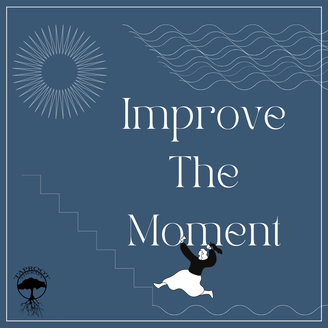|
TAPROOT BLOG: Psychoeducation for Clients and Providers
|
|
Guest writer: Anastasia Polar-Vivona, MHC-LP
Cope Ahead is a Dialectical Behavioral Therapy (DBT) Emotional Regulation skill. We are currently in the holiday season, which can bring up some uncomfortable emotions. The holiday season is a time where we are around our friends and families, which for some can bring up uncomfortable and overwhelming feelings and thoughts. During these times, it can be common for us to resort to ineffective coping methods. Does this sound like something you have experienced or are currently experiencing? The Cope Ahead skill could be for YOU! Cope Ahead: 5 Steps With these five steps, you can learn how to prepare for difficult situations.
Cope Ahead can be a challenging skill to practice. Like with practice of any skill, you will feel more confident over time. The more we practice, the more we feel in control of our responses! IMPROVE the moment is a distress tolerance skill in Dialectical Behavior Therapy (DBT). It is a skill to help us in the midst of challenging times. It doesn’t necessarily mean that we automatically feel better, but it can help us from feeling worse.
I: Imagery Use imagery to help you cope. You can imagine yourself in a safe place. You can imagine yourself coping with the difficult situation you’re experiencing in an effective way. You can imagine a place that makes you feel happy. Any images that help you feel safe and calm. M: Meaning Make meaning out of your pain. This can be a challenging skill, because at times, we aren’t ready to make meaning. There are times, however, when we can look at a painful experience, and see what we can learn from that experience or how we can grow. We can also make meaning by finding moments of gratitude within our pain. For example, we can express gratitude for a friend or loved one who supports us in our pain. P: Prayer Prayer can mean many different things! It can be praying to God, or it can be praying to a higher power. Prayer can be connecting with Wise Mind, meditating, or setting intentions. It can be going on a hike and taking in nature. It can be volunteering and connecting with your larger community. Prayer can be anything that allows you to connect with a higher power. R: Relax Engage in relaxing activities. Take a gentle yoga class or practice deep belly breathing. Try a half-smile meditation. Take a hot bath or shower. Drink a cup of your favorite tea. Hug a friend or family member. Watch your favorite movie snuggled up in your favorite blanket. O: One Thing in the Moment Similar to the DBT mindfulness skill, One-Mindful, be mindful of what you are doing, and only do one thing at a time. So often, we multitask. Instead, put down your cell phone, stop scrolling through social media, turn off the television, and just do one thing in the moment. V: Vacation Give yourself a vacation! This can be a week-long European destination trip, or it can be a brief 10-minute vacation in your mind. It could be imagining yourself going on a dream vacation, or it can even be giving yourself a few hours, removed from work, and watching your favorite TV show. E: Encouragement Be your own cheerleader! Talk to yourself the way you would your best friend who might be struggling. While this can be challenging to do, tell yourself all of the ways you are coping well. Encouraging statements like, “you got this!”, or “you’re doing a great job,” can help us in challenging times. Therapy is great! It gives us the space to process our thoughts and feelings in an unbiased, judgment-free zone. It helps connect our thoughts, feelings and behaviors in ways that we might not otherwise notice. And, it allows us to see patterns in our behaviors that can often impede our growth. But sometimes, we simply need to feel better. We need to soothe ourselves, or regulate our emotions, in order to do some of that processing and connecting work. That’s where a Dialectical Behavior Therapy (DBT) skills group helps. DBT is an evidence-based treatment that helps us with mood regulation, mindfulness, impulsive behaviors, and strengthening our relationships. It provides us with active and behavioral skills and tools to use when we are feeling emotionally heightened. When we feel like we are ready to explode, breakdown, scream, or punch a hole in the wall, that is not the time to process and explore our feelings. We do that after we’ve had some distance from our emotions, because we have to be vulnerable and willing to be curious about why it is present. But when it’s present, it feels all-consuming, and our main task is deescalate. Then, we can do the other work! But in order to get there, we have to use some DBT skills first. How does it work? DBT is split into four skill modules: mindfulness, emotion regulation, distress tolerance, and interpersonal effectiveness. In each module, one learns over 70 skills! Mindfulness covers skills that allow us to be present and identify what we are feeling. Emotion regulation skills help us stay calm and collected, and help us identify when we need to decompress. Distress tolerance skills help us get through times when our emotions are really heightened, but we are in a place where we can’t address them (say, in an important meeting with your boss). And interpersonal effectiveness skills are tools that help us maintain and nurture our relationships. At a DBT skills session, participants complete a weekly diary card that tracks the intensity of one’s moods, as well as which skills one uses throughout the week, and how helpful those skills are. Each session also covers skills to practice. Outside of the sessions, participants receive 15-minute coaching calls with an expert therapist (the therapist leading the sessions) to help review use of skills in challenging situations. Why join a DBT group? DBT is helpful for people experiencing anxiety, depression, eating disorders, and impulsive behaviors. It helps us identify skills that we can use in the moment to alleviate our symptoms and strong emotions. DBT also helps us effectively set boundaries with others, and create that self-care/wellness plan that we can never quite seem to put into place, despite our best intentions. Taproot Therapy is running a DBT group starting October 13! We love running DBT groups, and are excited for our next group. This group will run virtually for 10 weeks, every Wednesday from 5:30pm-7pm, and will be led by our lead clinician and DBT expert, Erin Iwanusa, and co-facilitated by therapist, Bridget Carey. During this group, we will complete diary cards, learn skills in each of the four modules, and leave you with a plan to utilize these skills. For more information, click here! For more DBT skills check out our DBT blog, or listen to our podcast, Taproot Therapy: A Mindful Moment (we even have a DBT challenge that's available on our podcast!). When our emotions become overwhelming, it can be hard to respond to them. If we feel depressed, we might feel stuck or trapped, and all we want to do is sit on our couch and mindlessly scroll through Instagram. Other times, we can feel so angry that we want to punch a hole in the wall.
But, instead of getting stuck on our couch, we call a friend and go for a walk. Instead of punching a hole in the wall, we pause and take some deep breaths. This is the Dialectical Behavior Therapy (DBT) skill, Opposite Action to Emotion. Opposite Action to Emotion is a skill that helps us actively and behaviorally do the opposite of what we are feeling. Our emotions can often attempt to dictate our behaviors. And, our behaviors can directly impact our moods. Thus, if we do the opposite of what we are feeling, we will change our mood, and start to feel better. How Does it Work? Our thoughts, feelings and behaviors are all connected. For example, if I think, “I’m a loser, I have no friends, and everyone hates me,” I will start to feel sad or depressed. As a result of feeling sad or depressed, I might pull away from those who love me. I might binge eat, or misuse substances. But, if we were to change my thought to, “Right now, I feel lonely,” we might reach out to people we trust. How to Practice Opposite Action to Emotion First, identify what you are feeling. Name your emotion: sad, angry, depressed, anxious, worried, irritable. Once we can label our emotion, we know what we need to do to change it. Next, do the opposite of what you are feeling. For example: If you're feeling sad, do something that makes you happy: go for a walk, pet your dog, call your best friend, or watch a funny movie. If you're feeling angry, do something soothing: wrap up in a soft blanket, light a candle, drink a cup of hot tea, or meditate. If you're feeling anxious, do the thing that makes you anxious (but be safe. If you are anxious about walking home alone at 3am, don’t walk home alone at 3am)! If you are scared to speak to someone, speak to them. If you are nervous to go out, go out. If you are scared to ask for a raise at work, write out what you want to say and then ask for that raise! The idea is that we stop engaging in behaviors that amplify our unwanted feelings, and start engaging in behaviors that help us feel better. As with all DBT skills, this takes time and practice in order to see results. Create your own list of actions you can take when you are experiencing difficult feelings. What are the things you do that are opposite from how you are feeling? We all like to feel accomplished. We like to feel that we are good at something. Knowing that we are skilled in certain areas helps us feel grounded and regulated. It can also increase our feelings of happiness.
Building Mastery is an emotion regulation skill in Dialectical Behavior Therapy (DBT), that helps us build awareness of, and practice, things we do well. Emotion regulation skills support us in both becoming aware of our emotions, and mindfully responding to our emotions. Thus, when we build mastery in something, we are able to respond to emotions in a supportive and mindful manner. There are two ways we can build mastery: 1.Recognize the things you are already doing well. 2.Learn something new and watch yourself grow. The first way to is recognize those things we are already doing well. Maybe you are really good at leading team meetings at work. Or, you cook an amazing chicken stir fry. Some of us are skilled knitters and painters. Others of us have excellent driving records. Identify all of the things that you are already doing well, and notice how you feel when you do those things. The second way we can practice building mastery is by learning new things and witnessing ourselves gaining competence in new skills as we practice them. Think about when you first learned to drive as a teenager. At first, it was a new skill, and you had no idea how to drive. You might have felt frustrated, angry, and you might have even dreaded getting into the driver’s seat! Now, think about how you felt when you passed your drivers’ test and got your license. You probably felt a big sense of accomplishment! When we learn new things, and when we watch ourselves grow, we feel excited and proud. What are some ways you build mastery? In the Netflix show, “Unbreakable Kimmy Schmidt,” the title character, Kimmy, has to turn a crank. It’s an endless and meaningless activity that she is forced to do. To get through the activity, she counts to 10. And when she gets to 10, she starts again. Kimmy states that she can do anything for 10 seconds. There’s research that supports this! Researchers estimate that our feelings only last approximately 90 seconds. It’s a bit longer than 10 seconds, but 90 seconds is astonishingly short. Practicing Riding the Wave
Riding the Wave of Emotion is a distress tolerance skill. Imagine your feeling as if it were a wave. It starts small, barely noticeable. It grows, until it reaches its peak. The peak of that wave lasts approximately 90 seconds. And then, our feeling naturally starts to decrease in intensity, until it subsides completely. While the entire wave of emotion might last longer than 90 seconds, the emotion at its most intense point will be short lived. In order to practice this skill, you simply have to be mindful of how you are feeling, and where you are on that emotional wave. This skill allows you to track your emotion as it hits the peak and declines. This skill is helpful when you are feeling overwhelmed by emotion, but aren’t necessarily sure how to respond to it. By simply being present to the wave, you are responding to your emotion! This is also a helpful skill for navigating urges. Our urges, just like our emotions, will subside. Urges can include self-harm, overeating, using substances when you don't want to, or any other habits you are hoping to break. Considerations This skill is also helpful because there are times when we want to remain upset, anxious, angry, or whatever big feeling we are experiencing. And yet, as with all things in our lives, our emotions have a natural start and end point. They come and go. And when it is time for them to subside, this skill can help us do that. If you start to feel yourself trying to climb back up to the peak of the emotional wave, remind yourself that emotions are meant to crash on the shores, just like waves. Distress tolerance skills help us tolerate distressing moments in our lives, by validating the distress while actively engaging in activities to ease it. One of the skills DBT prescribes is ACCEPTS. ACCEPTS is an acronym for active things we can do to support ourselves through these times.
A: Activities. Simply put, do something to get busy. Exercise, clean the house, engage in a hobby. Get moving! Do something that requires enough of your attention to distract you from your unpleasant feeling. In doing so, you’ll also feel productive! C: Contributing. By giving our time and energy to others, we feel connected to our friends, family and community. This helps us build our positive emotions! In this pandemic, you may feel limited in what you can do. It’s important to remember that any little bit helps: shopping locally, tipping our delivery people well, video chatting with a friend who may be quarantined alone, sending a Venmo tip to our musician and comedian friends continuing to put their work out in the world. Now more than ever is a great time to contribute to others in any way we can. C: Comparisons. This skill is a tricky one. On one hand, comparing ourselves to others can lead to negative self-image. We can feel scarce, rather than abundant in what we have. Comparison can also be problematic when we use it to compare suffering. All suffering is valid and warrants validation. Comparison, however, can be helpful when expressed from a place of gratitude. It can also be helpful when we compare ourselves to our previous selves, and recognizing the progress we have made. E: Opposite Emotions. Actively do the opposite of what you are feeling. If you are feeling sad, watch a funny movie. If you feel anxious, do something that calms you down, such as meditation or gentle yoga. If you are feeling like you want to pull away from someone you love and trust out of embarrassment, fear, or shame, reach out to them. P: Pushing Away. We do not have control over the first thought we have. Many of our thoughts are automatic. We do, however, have control over what follows our automatic thoughts. Our brain is incredibly powerful and can be used to reframe thoughts and use visualization to reduce unwanted thoughts and replace them with wanted thoughts. T: Thoughts. Distract yourself with a positive thought. Say a prayer, count to 10, count your breaths, think about someone you love. Making a list ahead of time of our positive thoughts can also be helpful. S: Sensations. Use a physical sensation to provide you with a distraction. This is helpful when we are feeling more dysregulated than usual; times when we feel we’ve tried everything in our bag of tricks, and nothing seems to be helping. Intense sensations, such as splashing cold water on your face, calms the brain for a brief period of time, giving us space to implement other calming tools. Other sensations can be taking a hot or cold shower, listening to loud music, or even listening to soothing sounds, such as rain falling or a meditation bell.  Taking care of our relationships is integral to our emotional wellbeing. But, we also want to care for ourselves in our relationships. By setting our boundaries and practicing self-respect, we improve our relationships and ourselves! FAST is an interpersonal effectiveness skill in Dialectical Behavior Therapy (DBT) that helps us do that. F: Fair Be fair to yourself by honoring your values and your boundaries. More importantly, don’t put others’ needs before your own. We have to be fair to ourselves and prioritize ourselves in order to be supportive of others. A: Apologies Apologize when necessary, but don’t apologize when one is unwarranted. We apologize so often when one is not needed. Don’t apologize for your presence, for your opinions, or your thoughts. Rather than apologize when you don’t need to, express gratitude to the other person. (For example, instead of saying “I’m sorry for being late,” say, “Thank you for waiting for me!”). S: Stick to your values First, identify your values. Once you have identified what your primary values are, you can stick to them. Don’t abandon your values when in relationship with others. Honor your values – these are the things you feel shape your life! Values are important, and by honoring our values, we stay true to ourselves while in relationships with others. T: Truthful Tell the truth! There is a saying therapists have: if a client is lying in session, they are lying to themselves. And the same might be true in our other relationships. Being honest in your relationships and with yourself helps honor others. It fosters relationships and builds safety in relationships. How does the FAST skill work for you? DBT provides many mindfulness tools. One of those tools is the Half Smile meditation.
The Half Smile meditation is a tool that can be soothing, silly, or comforting. It is a tool we can use to honor what we need in that moment. What is the Half Smile Meditation? The Half Smile meditation is a practice where we gently smile as we meditate. Here are the steps to practice the Half Smile meditation: 1. Sit in a comfortable position. You can sit with your legs crossed on the floor, or sitting in a chair with your feet firmly planted on the ground. 2. Start by taking slow breaths. 3. After a few breaths, and after you feel grounded into your seat, begin to smile. Do not create a full smile; rather, form a small half smile to the extent that you feel able. 4. Sit, half smiling, for as long as you wish. Why the Half Smile Meditation is helpful? Sometimes, we feel so sad that the last thing we want to do is smile. When we smile, however, we are sending a message of comfort and support to our brain. Thus, by doing a half smile rather than a full smile, we are engaging in an activity that might feel manageable when a full smile does not feel possible. Sometimes, this activity can feel a little silly. And that’s ok! If you feel silly during this exercise, it might be an indication that you want or need a good laugh. Other times, a half smile can simply soothe and comfort us. With all mindfulness activities, participate in the activity and trust where the meditation takes you. Your only job is to notice what arises as you practice. There are times in our lives when we have to ask for something, say no, or assert ourselves. And that can feel hard! Maybe sometimes we are interacting with a challenging person in our lives. Or maybe we struggle with regulating our own emotions when we have to have these difficult conversations. DEARMAN is a DBT skill that helps us through these conversations. It is an interpersonal effectiveness skill that gives us a script for how to talk to others while respecting both our boundaries, and the person to whom we are speaking. D: Describe First, start out by describing the facts of the problem. And only the facts! We scheduled a meeting for today, and you canceled our meeting 20 minutes before it started. Simple, short, and only the facts. E: Express Second, share your feelings about the situation. I felt frustrated because I rearranged my entire day to meet with you. I felt upset because I was looking forward to meeting with you. I felt worried because I thought you had an emergency. A: Ask, assert, or say no. Next time, I need more notice before you cancel so I can rearrange my day. In the future, can you let me know the day before if you need to reschedule? R: Reinforce Sometimes, this is simply saying thank you. Other times, it’s reinforcing the other person’s good behavior by modeling the behavior you want to see. Thank you for being considerate of my time. Thank you, and I will also give you the same courtesy. M: Mindful Be present and focused as you speak. Don’t multitask. Focus your energy on being present to the conversation. A: Appear Confident This one can be hard! Remember that asserting ourselves can be intimidating. You are not alone in that feeing. Use the skills you have to appear confident in these conversations. N: Negotiate
These conversations cannot be one-sided. If we ask something of others, we want to listen to their response as well. Sometimes, we have to negotiate with others. That’s part of being in relationship with others! |
Categories
All
Archives
May 2024
|
|
Taproot Therapy, LCSW, PLLC Annie@taproottherapynyc.com 285 Lexington Avenue Suite 2A New York, NY 10016 141 E 35th Street Suite J New York, NY 10016 |
|








 RSS Feed
RSS Feed
